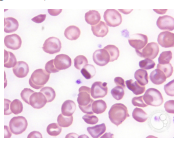What is hemoglobin?
Hemoglobin is the part of red blood cells that carries oxygen to all parts of the body. The usual type of hemoglobin is called hemoglobin A. Genes that we inherit from each of our parents determine what type of hemoglobin we have.
What is hemoglobin C?
Hemoglobin C is a hemoglobin protein that is very slightly different from the common Hemoglobin A, and shows up separately on special testing. It is different in that it behaves like a mild sickle cell trait. Thus Hemoglobin C itself can cause unusual looking “target” red cells (see picture), but is not a disease.

What is hemoglobin C trait?
Hemoglobin C trait means one gene for the usual hemoglobin (A) is inherited from one parent and one gene for hemoglobin C from the other parent, usually resulting in no symptoms. When someone inherits the gene for hemoglobin C from both parents, that person has homozygous (same genes) hemoglobin C that causes mild anemia with unusual looking red cells (target cells) that does not cause problems.
